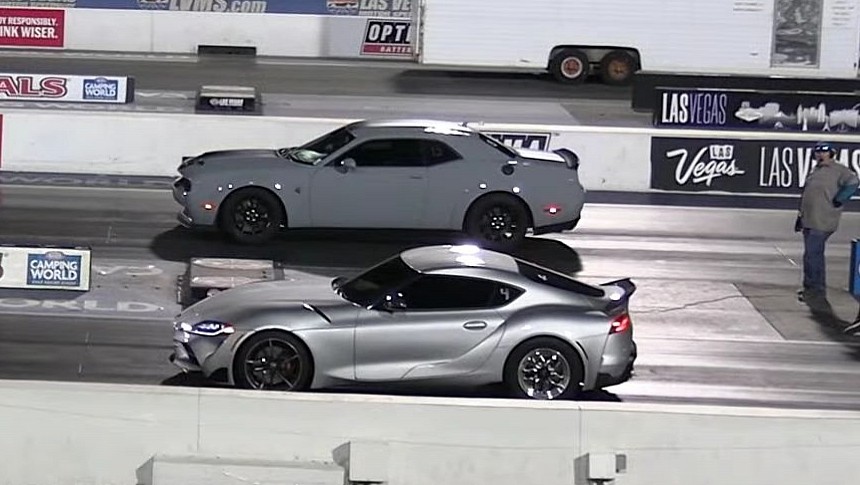With Dodge pulling the plug on all things Hellcat, it's high time for us to remember that Hellcat-engined vehicles are stupidly good in the quarter mile. The following video comprises two drag races, with two Challenger SRT Hellcats duking it out against two Supras with straight-six engines.
Pictured at the Las Vegas Motor Speedway's drag strip, the first pair consists of a wide-bodied muscle car and a Supra with drag wheels and radials for the rear end. The Challenger's driver didn't warm up his rear before launching, yet still made easy work of the contestant in the inline-six Supra Mk V.
How big of a difference are we talking about? The Supra crossed the finish line in 14.42 seconds at 96.82 miles per hour (make that 156 kilometers per hour). As for the victorious Challenger SRT Hellcat Widebody, the numbers are 12.29 clicks at 118.81 miles per hour (191 kilometers per hour).
Pretty significant difference, all the more if you remember the super-sticky rubber boots fitted to the rear of the Supra. Next up, the second pair stars a regular-bodied Challenger SRT Hellcat with rear drag radials and a 'Yota with road tires.
Despite a whole lot of wheelspin for both cars, the Hellcat-engined muscle car scooted off into the distance, leaving the Supra in the dust. 13.47 seconds at 110.82 miles per hour (178 kilometers per hour) are better numbers than before, and the same can be said about the Challenger SRT Hellcat: 11.76 seconds at 126.33 miles per hour (203 kilometers per hour).
As you're well aware, Stellantis – the automaker created by the merging of Groupe PSA with Fiat Chrysler – is transitioning to electric and electrified vehicles at a speedy pace. Even though Dodge couldn't care less about the upcoming Euro 7 regulations in Europe, the Corporate Average Fuel Economy is a pain in the you-know-what. Once ubiquitous, the HEMI engine family is going the way of the dodo because of CAFE standards. The indirect replacement for the 5.7-liter HEMI in the Ram 1500 pickup truck, for example, will be replaced by a twin-turbo inline-six that Jeep refers to as the Hurricane.
On paper, it's a good engine: 510 horsepower and 500 pound-feet (678 Nm) of torque, which is 40 and 45 better than the 6.4-liter HEMI in the Jeep Grand Wagoneer. Those numbers challenge the BMW M-specific S58 mill of the M3 and M4, whose maximum ratings are 553 horsepower in the 3.0 CSL and 479 pound-feet (650 Nm) for the Competition specification.
It's not known if the Challenger will ever come back, yet we do know the Charger will morph into an electric three-door liftback coupe with serious quarter-mile credentials. The Supra, on the other hand, is reportedly getting a high-performance GRMN version before it gets discontinued. There is hearsay in regard to an EV-only sixth generation, but Toyota hasn't commented on this probable outcome thus far.
How big of a difference are we talking about? The Supra crossed the finish line in 14.42 seconds at 96.82 miles per hour (make that 156 kilometers per hour). As for the victorious Challenger SRT Hellcat Widebody, the numbers are 12.29 clicks at 118.81 miles per hour (191 kilometers per hour).
Pretty significant difference, all the more if you remember the super-sticky rubber boots fitted to the rear of the Supra. Next up, the second pair stars a regular-bodied Challenger SRT Hellcat with rear drag radials and a 'Yota with road tires.
Despite a whole lot of wheelspin for both cars, the Hellcat-engined muscle car scooted off into the distance, leaving the Supra in the dust. 13.47 seconds at 110.82 miles per hour (178 kilometers per hour) are better numbers than before, and the same can be said about the Challenger SRT Hellcat: 11.76 seconds at 126.33 miles per hour (203 kilometers per hour).
As you're well aware, Stellantis – the automaker created by the merging of Groupe PSA with Fiat Chrysler – is transitioning to electric and electrified vehicles at a speedy pace. Even though Dodge couldn't care less about the upcoming Euro 7 regulations in Europe, the Corporate Average Fuel Economy is a pain in the you-know-what. Once ubiquitous, the HEMI engine family is going the way of the dodo because of CAFE standards. The indirect replacement for the 5.7-liter HEMI in the Ram 1500 pickup truck, for example, will be replaced by a twin-turbo inline-six that Jeep refers to as the Hurricane.
On paper, it's a good engine: 510 horsepower and 500 pound-feet (678 Nm) of torque, which is 40 and 45 better than the 6.4-liter HEMI in the Jeep Grand Wagoneer. Those numbers challenge the BMW M-specific S58 mill of the M3 and M4, whose maximum ratings are 553 horsepower in the 3.0 CSL and 479 pound-feet (650 Nm) for the Competition specification.
It's not known if the Challenger will ever come back, yet we do know the Charger will morph into an electric three-door liftback coupe with serious quarter-mile credentials. The Supra, on the other hand, is reportedly getting a high-performance GRMN version before it gets discontinued. There is hearsay in regard to an EV-only sixth generation, but Toyota hasn't commented on this probable outcome thus far.













